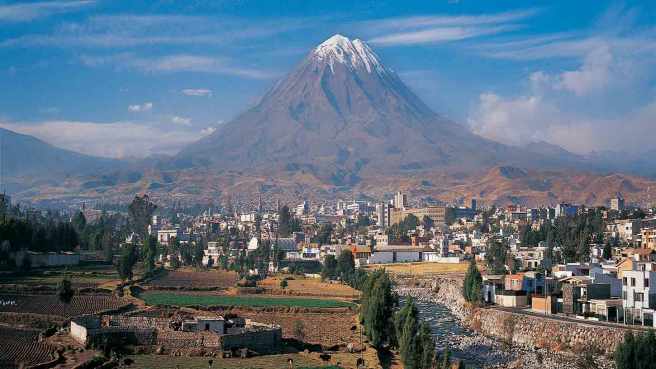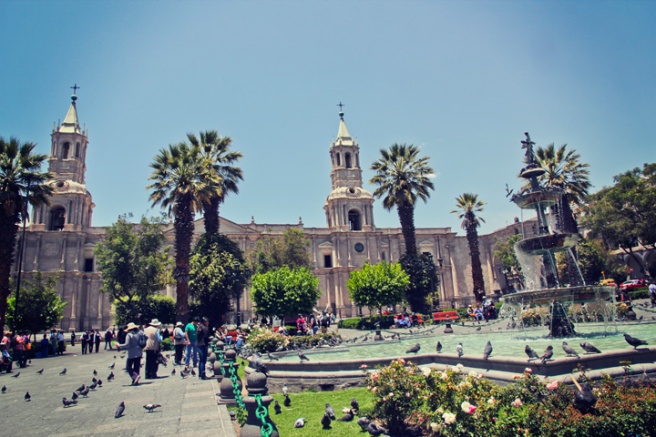We made it to Peru, although it wasn’t without any bumps in the road! Our flight from NYC to Lima was delayed, which caused us to miss our connection to Arequipa. However, we were able to be booked on the next flight in to Arequipa, thank goodness! All of this meant that we didn’t have time to change or refresh prior to meeting the President and faculty of the Univeridad Catholica de Santa Maria. Definitely one of the most embarassing moments of my life. The President and faculty were all dressed so nicely and professionally in suits, and we stroll in with leggings and sweatshirts straight off of many plane rides. But, the university was so welcoming (regardless of our appearance) and excited to have us in Peru that it definitely made up for the embarassment level we felt. That moment set a wonderful tone for the rest of the trip to come.
The rest of the weekend, we went sightseeing – we visited a museum and saw the mummy of Juanita, went to Monasterio del Carmen, went shopping throughout the city, and took a bus tour of the city of Arequipa. The bus tour was amazing, because it allowed us to see the outer limits of the city that we wouldn’t have seen if it weren’t for this tour. This tour allowed us to experience firsthand things we’ve learned throughout our curriculum. For example, we saw the living conditions, the lack of resources, the distance one must travel to receive health care, among various other factors that contribute to poor health. It felt so surreal to experience firsthand much of what is being taught to us.
On Monday, we went to work at a health clinic in Arequipa. This health clinic is amazing because it contains so many resources all in one – diabetes and blood pressure screenings, tuberculosis clinic, pediatric clinic, adolescent counseling, emergency medicine, maternity, nutrition, and community health nursing. For a clinic with few resources, the work they are doing is incredible.
My first day, I went on the community health nursing visits. This experience was much different than in the United States. For example, nurses within the US see at least 5 patients a day (usually more) and they drive to and from patients. However, in Arequipa, nurses see only a few patients a day and walk to patients houses. Also, in Peru, community nursing is more preventative, whereas in the US it is a more focused visit, like for wound care. On our community visits, we went to families homes with children under 3 years old. The government requires that children under 3 years old receive micronutrients or “sparkles” to prevent anemia. Therefore, for parents who cannot bring their child to the clinic, nurses go out into the community to bring the nutrients to the family. The micronutrients contain calcium, magnesium, folic acid, iron, etc. Our first patient was a 13 month old boy named Mauricio who was with his grandparents while his parents worked during the day. I was shocked at how willing the grandparents were to not only listen to the nursing education, but to also welcome and encourage that I played with Mauricio by immediately handing him over to me. It was really amazing and not something I see in the US. Also, I was shocked that when the grandmother mentioned she has back pain, the nurses did not physically assess her. They asked her questions but never once inspected or palpated the area, which is very different than in the US. I am used to seeing a series of questions being asked followed by physical assessment of the complaint, so experiencing this was very eye-opening!
Another part of the community assessment that stood out to me was when we went to an area called El Azufral, which would be considered the slums. This area was situated in a valley, so stairs were required to access the area. El Azufral also lacked electricity, running water, and toliets. The houses were made of concrete, rocks, and any other useful materials, all lining dirt roads. Unfortunately, the families did not answer the door for our visits, however, it was extremely eye-opening to be in this area. I couldn’t believe that this was a standard way of life for some people – maybe I’m just naive? But walking through it rather than just looking down on the area seemed to really exemplify the quality of life these individuals have.
On Tuesday, I worked in the Pediatric clinc with nursing student Cristina and Peruvian nurse Leslie (Both of which are incredible!). In the pediatric clinic, I was able to watch “controls” or assessments done on children of various ages (typically less than 4 years old). The clinic also gave vaccines to pregnant mothers as well as several children who had dog bites. During the assessments, I was able to see the difference between ages, what they need for vaccines, as well as the developmental stages. Overall, the children appeared to be bigger than US babies and children, both in height and weight. Also, the mothers were very receptive to having me in the room with them while the controls were being performed. For the controls, a newborn (7 days old) had only the height and weight taken. However, for a 3 year old, a complete physical exam was performed as well as developmental tests and vaccines were administrerd. There was also a difference in the focus of the assessments. The Peruvians placed a lot of emphasis on the arches in feet, as it can relate to kidney damage later in life. However, in the US, arches are not something that is focused on. Therefore, it was awesome to see the difference in practice and the implications it can have on the child. Lastly, a big difference I noticed was with infection control. In between patients, there was minimal hand washing, the beds/tables were not cleaned after use. Also, for vaccines, the vials were never cleansed prior to insertion of the needle, and the nurse used soap on a cotton swab to cleanse the area on the patient rather than alcohol like in the US. I’m unsure if it is due to lack of resources or knowledge, but it was interesting in the vast difference of infection control between Peru and the US.
Unfortunately, on Tuesday afternoon, another student and myself got sick and had to go to the Univeridad Catolica de Santa Maria’s doctor to be examined. We both had fevers, stomach pains, muscle aches, and were exhausted. So on Wednesday, I had to sit out of clinical, but I feel much better now and am looking forward to diving back into clinical on Thursday!! (What can ya do, right?)
Ill post some pictures once I get some free time!
Adios!


